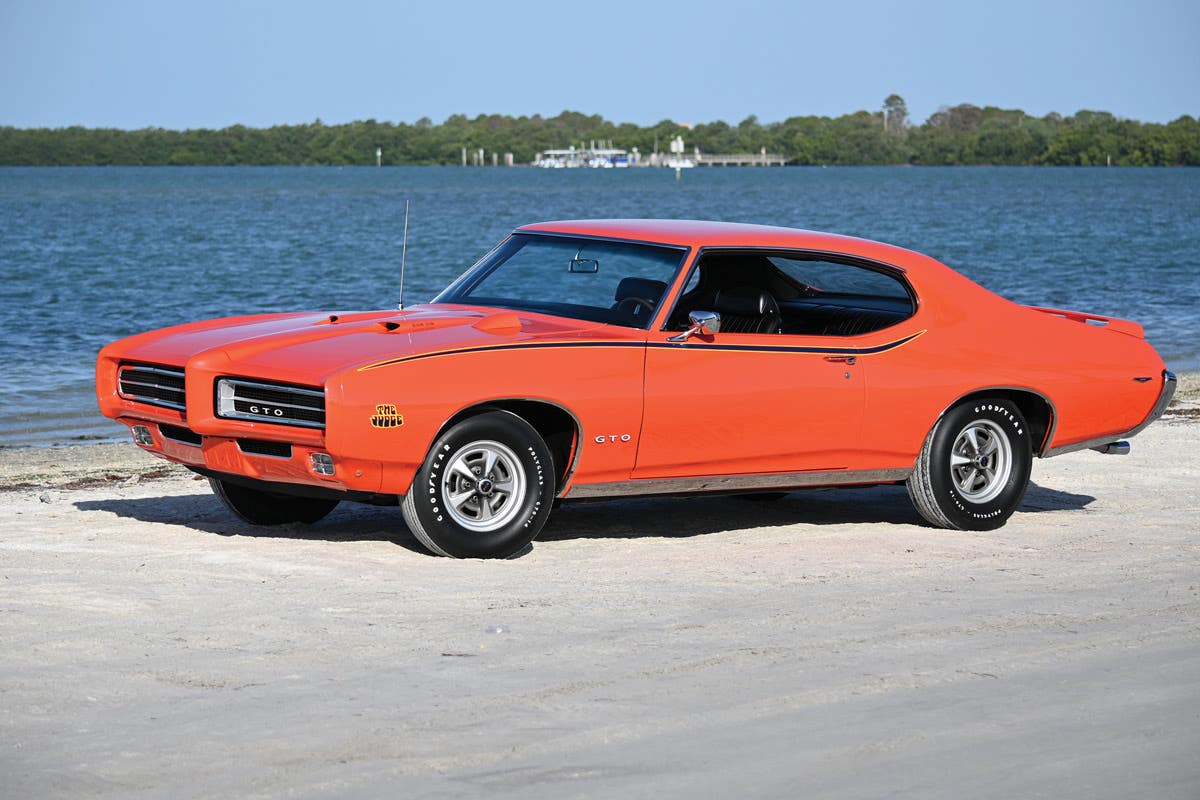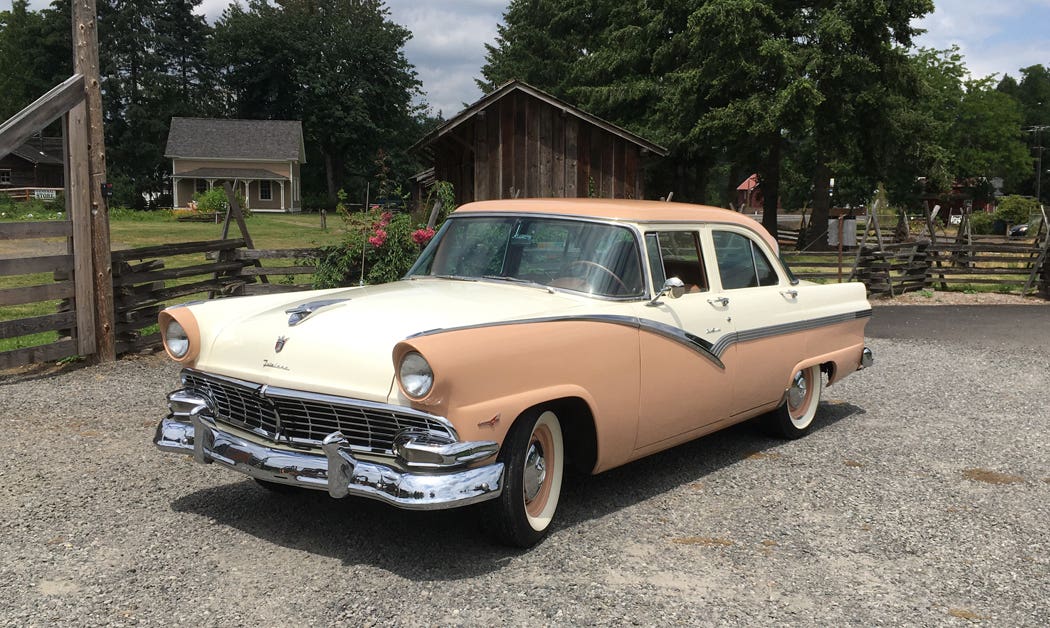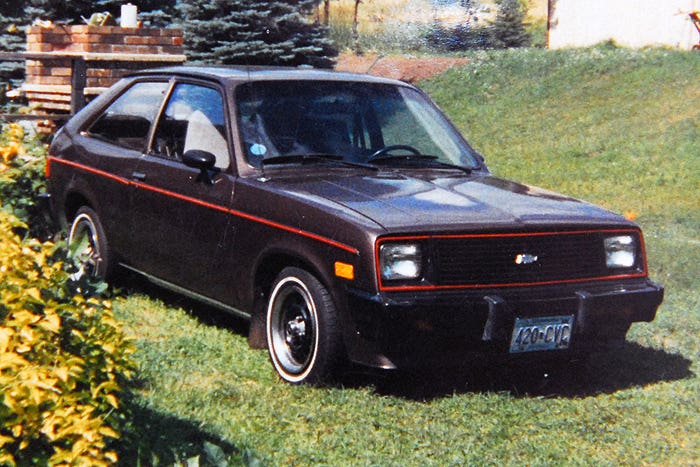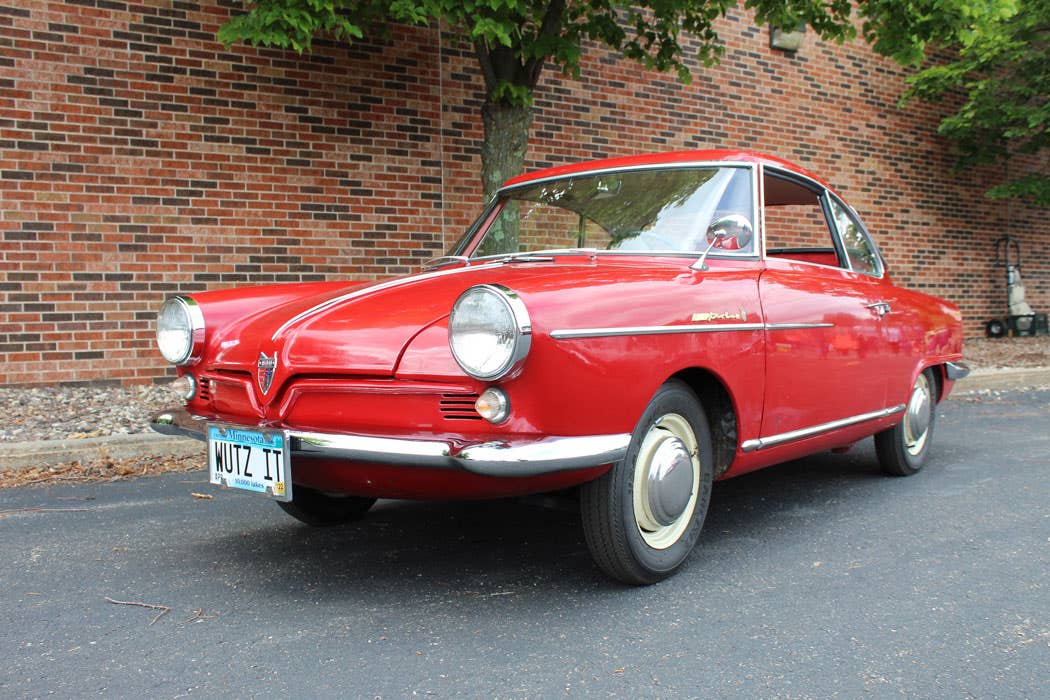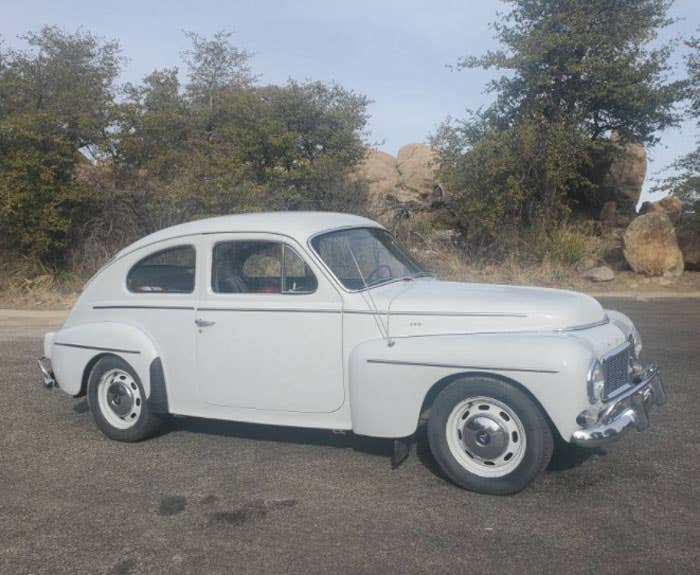Bee-yutiful!: Rare 1955 Ford is hard to miss
Around St. Paul, they call Cindy Dudeck the “Bumbl-B Lady,” but she isn’t yellow and black, nor does she does fly. However, that description fits Cindy’s 1955 Ford Sunliner convertible, one of the few Fords painted in the striking Goldenrod Yellow and Raven Black paint scheme featured in many Ford ads and showroom floors after the ’55 Ford’s mid-November 1954 introduction.
Around St. Paul, they call Cindy Dudeck the “Bumbl-B Lady,” but she isn’t yellow and black, nor does she does fly. However, that description fits Cindy’s 1955 Ford Sunliner convertible, one of the few Fords painted in the striking Goldenrod Yellow and Raven Black paint scheme featured in many Ford ads and showroom floors after the ’55 Ford’s mid-November 1954 introduction.
With very few exceptions, American cars of 1955 are stunning. From the independents to Chrysler Corp. to Ford Motor Co. to General Motors, there’s hardly an ugly duckling in the pond. Many designs of the 1955 automobiles were new, and those that weren’t new were still fresh. Chevrolet wore a beautiful new body design incorporating a wrap-around windshield and offered a hot new V-8 under the hood. Plymouths bore the pen of Virgil Exner, who drew beautiful lines for the car under his “Forward Look,” and like postwar Chevrolet, Plymouth had its first V-8 engine. Ford was moving onto its second year with the new Y-block, overhead-valve V-8, so its big news was the handsome, fresh sheet metal with “Thunderbird styling” that made it a formidable contemporary in a sea of tough choices for any new-car buyer.
To help the new Fords stand apart in one of the toughest beauty competitions the company had entered since 1932, the company marketed the new full-size 1955 models with the smaller two-seat Thunderbirds in brightly colored magazine ads. The Thunderbirds in those ads were often an attractive blue, red or black, but when paired with a drop-top Sunliner, the Thunderbirds were outshone by the Sunliner’s trendy two-tone paint treatment in a striking black-and-yellow combination.
An affinity for Fords
Ford advertising also promoted owning not one, but two, new 1955 Fords. The Dudecks have taken that to heart and upped the number exponentially. More than 20 1955-’56 Fords have graced their garage, which currently houses a glass-top 1955 Skyliner in addition to the convertible Sunliner.
Butch was the first to be attracted to the beauty of the 1955 and 1956 Fords, and that was several decades ago. Since then, he has restored and refurbished numerous mid-1950s Fords, even before the couple married.
“I always liked a car with a lot of chrome,” Butch said. “I was going to buy a 1956 Chevy, then I saw a Crown Victoria and that was it.”
After they pair met, it didn’t take long for Butch’s appreciation for mid-1950s Fords to rub off on Cindy. At first, Butch was a little worried about what Cindy would think as he was preparing to bring his next restoration project home after they were married.
“I told her not to get mad when I brought the next car home,” Butch said. That Ford was a $75 1956 Victoria two-door hardtop with the roof pushed down to the top of the seats.
“In a week, he put a new roof on it, then turned it into a Crown [Victoria],” Cindy said. When the car was sold, the couple put a down payment on their first home together, and Cindy was sold on the old-car hobby. After seeing the crushed-roof Victoria come together, Cindy was so excited about the hobby that she formed a local Ford club named Fords Better Idea (FBI), which appreciates fords of the fifties. Butch and Cindy are also 25-year members of the Crown Victoria Association, which appreciates all 1954-’56 ford products.
After the Victoria project, the Dudecks found a white 1956 Sunliner convertible and gave it a quick paint job and some other improvements. The couple took the Sunliner to the Minnesota Street Rod Association’s Back to the 50’s event in St. Paul where they received a tempting offer to sell the car. After talking it over, the couple decided to part with the 1956 Sunliner and find another convertible project, even though 1956 Sunliners, and 1955s in particular, are hard to find. Butch then decided that the next project would be the most difficult 1955 Ford convertible to find — a factory yellow-and-black “bumble bee” Sunliner.
Finding their perfect Ford
“I was talking to a friend in the club with a red-and-white convertible, and I said I’d like to find [a yellow-and-black convertible], and he said ‘you’ll never find one,’” Butch said. Despite the lack of encouragement, Butch continued to spread the word, and eventually a truckdriver friend located a yellow-and-black 1955 Sunliner in North Dakota. That was in 1987.
Butch and Cindy immediately met the Sunliner’s owner and examined the car. What they found was no queen bee, but a serious project bee shrouded in white paint and looking more like bee “larvae.” The hood was off and laying over the back seat and top mechanism, the front floorboard was rusted through and the front seat was shot — all due to a leaky barn roof where the car had been stored. It became clear that, to make the bumble bee a honey again, it would take a lot of money and Butch’s expertise.
But there was good news. The car had been parked in 1964 after its owner, a salesman, had driven it only 79,000 miles.
While contemplating the purchase of the car, Butch asked Cindy to discreetly verify whether the car carried the VA paint code (Goldenrod Yellow lower body and Raven Black upper body) and R interior code (black and yellow). The car’s data checked out, but its price and condition gave them pause.
“We almost didn’t buy it, because he wanted too much for it,” Cindy said. “We weren’t rich, so $1,500 was a big investment.”
When they hauled the car home, they were greeted by many of their friends who were just as excited about the new project. Many had never seen a real yellow-and-black 1955 Sunliner off the pages of a magazine, and they weren’t going to let the chance pass by.
“The only other guy with a 1955 Ford Sunliner around made sure he was here to see the car,” Butch said. But even amidst the excitement, Butch was still feeling a little doubt about the purchase.
“After I bought it, I wondered, ‘what did I buy?’” he said. Not one to sit too long, Butch tore into the project, working on it every night and weekend. Six months and $6,950 later, the car was restored for the 1988 car show season.
Having already gathered a stash of parts and developed connections in the CVA, the Dudecks were able to keep the restoration costs down and accelerate the process. But that didn’t make it an easy project.
“Back then, you had to search for parts… you had to hunt for treasures – there weren’t reproduction parts out there yet,” Butch said.
Of the 20 or so 1955-’56 Fords owned by Butch and Cindy through the years, a 1955 station wagon purchased out of a farm field and used as a parts car for the bumble bee project definitely stands out.
“The headlights and taillights were wore from the cows rubbing on it,” Butch said. “When we pulled that car out of the farmer’s field, the cows followed it because they were attached to it. There were so many parts taken off that car, you wouldn’t believe it. It had a deluxe radio and lots of other parts.”
When it came to parting out the cars, Cindy was there pulling the delicate pieces from the instrument panel and other areas while Butch pulled the larger stuff. Some of the other parts necessary to restore the Sunliner were found through good friends in the club.
“One day, Gene [Nelson] walked up and gave Cindy a rare power steering horn ring and just said, ‘put it on the car,’” Butch said. Another friend gave the couple an NOS steering wheel and a deal on another hard-to-find part, an NOS trunk emblem — a part that often showed signs of wear after only a couple of years. Yet more help came from friend Greg Nelson.
Luckily, the unique convertible parts were well-preserved since the hood had been lying over the back of the passenger compartment, and many of those original parts are still on the car. However, nothing covered the front of the car during its storage days in the leaky barn so, among the parts requiring replacement were the bumble bee’s doors. Fortunately, Butch found a trick to replacing them, thanks to a friend’s parts stash.
“We looked all over for doors and couldn’t find them,” Butch said. Finally, while in his friend Doug’s grainery, Butch spotted a pair of doors from a 1955 Mercury two-door hardtop. Butch asked Doug what he was going to do with the doors, and the friend gave the doors to him.
“I looked at them and they had the same frame and glass,” Butch said. I couldn’t believe that they matched. They fit perfect and are still on the car.”
Before Butch stopped aggressively restoring cars, he completed the metal work of some serious projects. A mid-1950s Ford project saw Butch and his friends seamlessly mate a 1955 Ford Fordor’s complete floor pan, rear wheel openings and back portion of its tailfins to the mid-section of a 1956 Victoria with a rusty bottom end. Thankfully, the bumble bee project wasn’t that difficult, and even gave him a chance to do a different type of body work.
“I was just starting to do body work — the final work,” Butch said. He prepared the body for paint from his two-car garage in St. Paul and had his cousin, Gary Jurek, apply the Goldenrod Yellow and Raven Black paint that the car still wears today. In the end, one of the biggest expenses involved in restoring the Sunliner was its new convertible top.
A bee leaves the hive
When the car debuted in 1988, the Dudecks took the car to a show in Ellsworth, Wis., where it beat 86 other vehicles in its class for a first-place trophy. That was four days before the couple set out for a CVA national meet in Nashville, where the car received a third place trophy. Twenty years and 400 trophies later, the car scored a second place award in the convertible class at the 2008 Ellsworth show. It’s a testament to the car’s continuing appeal and the quality of Butch’s restoration work, as well as the work of friends who helped him.
“If there’s one thing I’ve enjoyed about this hobby, is the social life,” Cindy said, noting that people have recognized her in the grocery store and other public places because of her unforgettable Bumbl-B.
“People walk up to the car and say, ‘It’s a bumble bee car,’ then they see the personalized plates, which read ‘Bumbl-B,’” Cindy said.
Having a stand-out car also generates offers to buy it, and Cindy endures frequent offers. She’s even been flagged down in a parade by a police chief who wanted to buy the car, and the previous owner has joked that he’d like it back.
Since Cindy’s Sunliner has been a source of family pride and a link to many friendships through the years, it will be a long while before this bee leaves for another nest.
Angelo Van Bogart is the editor of Old Cars magazine and wrote the column "Hot Wheels Hunting" for Toy Cars & Models magazine for several years. He has authored several books including "Hot Wheels 40 Years," "Hot Wheels Classics: The Redline Era" and "Cadillac: 100 Years of Innovation." His 2023 book "Inside the Duesenberg SSJ" is his latest. He can be reached at avanbogart@aimmedia.com



